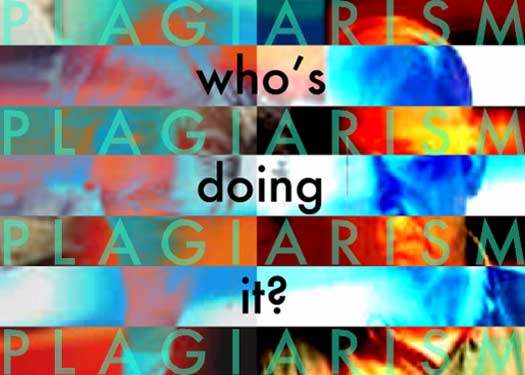
Plagiarism: Who is doing it and what has happened to them?
Scholars:
- Historian Doris Kearns Goodwin
- Source: Martin Arnold, “Historians Who Resort to Cutting and Pasting,”The New York Times, February 28, 2002, B1, B3
- Result: public censure
- Historian Stephen Ambrose
- Source: Martin Arnold, “Historians Who Resort to Cutting and Pasting,”The New York Times, February 28, 2002, B1, B3
- Result: public censure
Newspaper reporters:
- San Francisco Chronicle Editor Dean Wakefield
- Source: Dwight Garner, “Beg, Borrow, or Steal,” Salon.com
- Result: fired from job
- Associated Press Reporter Christopher Newton
- Source: Felicity Barringer “Wire Service Says Reporter it Fired Inventer His Sources.” The New York Times, October 22, 2002
- Result: fired from job
- New York Times Reporter Jayson Blair
- Source: Dan Barry et al. “CORRECTING THE RECORD; Times Reporter Who Resigned Leaves Long Trail of Deception.” NYT May 11, 2003, Sunday
- Result: fired from job
College professors and presidents:
- Hastings College President Richard E. Hoover
- Source: Denise K. Magner, “Plagiarism Charge Prompts President of Hastings College to Retire,” The Chronicle of Higher Education, March 3, 2000, A39.
- Result: retired under duress
- SUNY-Albany Classics Chair Louis W. Roberts
- Source: Sharon Walsh, “SUNY-Albany Classicist Loses Chairmanship After Being Accused Of Plagiarism,” The Chronicle of Higher Education, March 8, 2002, A12.
- Result: lost chairship
Politicians:
- Delaware Senator Joseph Biden
- Accused of delivering, without attribution, passages from a speech by British Labor party leader Neil Kinnock during campaign speeches for the 1988 Democratic presidential nomination.
- Source: Joseph Biden’s Plagiarism; Michael Dukakis’s ‘Attack Video’ – 1988.
- Result: compromised presidential campaign
- Prime Minister Tony Blair’s Office
- Admitted copying material from published sources. “Jane’s Information Group, the company that publishes journals and articles about military affairs, said three of its pieces had appeared uncredited in a British government dossier on Iraq.
- Source: “Group: Articles Copied in British Dossier, The Associate Press, February 8, 2003 New York Times.
- Result: public embarrassment
College students:
Limited published information on specific students exists. Anecdotal evidence suggests that cheating in college is rampant. Studies suggest that colleges and universities with honor codes have less of a cheating problem then schools without them.
Donald McCabe and Linda Klebe Treviño. “Honesty and Honor Codes.” Academe On-line. September-October 2002. Vol 88 #5.,
“New Research on Academic Integrity: The Success of ‘modified’ Honor Codes.” College Administration Publications, Inc.,
Muha, Dave. “Cheating, When Students Cheat.” Rutgers Focus. March 17,
“Maryland: 6 University Students Admit Cheating.” The New York Times. Friday January 31, 2003 A19.
Results: failing grades for assignments and courses, expulsion from school
High school students:
Limited published information on specific students exists. Anecdotal evidence suggests that cheating in High school is rampant.
Brigid Schulte, “Cheatin’, Writin’ & ‘Rithmetic”, The Washington Post, September 15, 2002
Katie Hafner, “Lessons in the School of Cut and Paste”, New York Times, June 28, 2001
Results: failing grades for assignments and courses